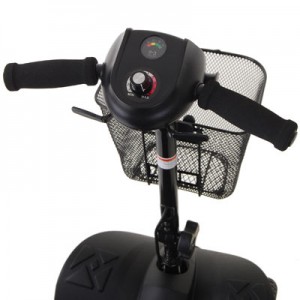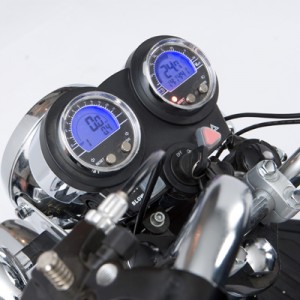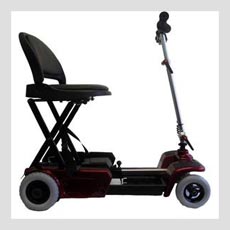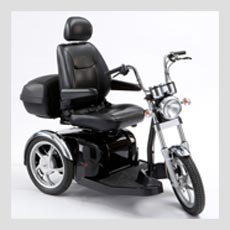Whether you already own a mobility scooter or you’re in the process of purchasing one, it’s incredibly important that you acknowledge and respect how a scooter works and that you consider it as any other road vehicle – it can be a dangerous piece of equipment if not used properly. Although mobility scooters are simple in design, the mechanics involved can be quite complex to understand, especially if you’ve never driven one before. This blog entry aims to help explain how to safely start, drive and brake, and how the controls may differ depending on the class of scooter.
Before starting the scooter, position yourself comfortably on the seat. Can you reach the handle bars? If not, adjust the tiller so you can place your hands securely. Ensure your feet on positioned on the scooter at all times. Do not turn the scooter on until you’re ready to go.
Turning On/Off
Due to being battery powered and hence not making much noise, it can be difficult to know when your mobility scooter is switched on. However, there are certain features installed which can making noticing this easier.
- Certain models will have a small green light fitted near the ignition. This would be lit when the scooter is switched on.
- Others may have a backlit battery dial which lights up when on.
Keep in mind that the scooter’s battery power will run low if it’s kept on unnecessarily. Remember to turn it off when not in use to maintain the battery’s power.
Ignition
The scooter’s ignition may be situated on the top of the tiller, underneath the handle bars, or lower down out of the way. Some models are fitted with an attached key, ideal for users who feel their memory may fail them, while others have a key that can be taken with you when you’re finished riding. While attached keys are great for users with issues with memory, it’s advised you only purchase this type of scooter if you’re able to lock it away in sheltered storage at the end of the day to prevent theft. Scooters with portable keys are easier to store as the key is kept away from the scooter when it’s not in use.
Acceleration
A scooter’s acceleration is controlled by levers fitted underneath the handle bars on the tiller. The lever design enables ease of use for many, but do test drive your chosen scooter before purchasing to ensure you’re able to control it properly.
Unlike cars and bicycles, mobility scooters are fitted with two levers to control its forward/reverse motion – it’s as simple as that! While one drives you forward the other enables you to reverse. It may take you a while to get used to this configuration but once you are you’ll be well on your way.
Although good dexterity is needed, a scooter’s levers don’t require a lot of pressure to get them to work. Squeeze down gently and your scooter will begin to move in your chosen direction.
Braking
Of course, once you’re on the move you’ll need to slow down and brake. However, your scooter’s brake configuration will depend on its class.
- Class 2 scooters (travel and pavement scooters) do not come fitted with brakes. To stop, just release the accelerator lever to gently slow down and come to a halt.
- Class 3 scooters (6-8mph road-worthy scooters) are fitted with a braking system in the form of handbrakes. Grip the handbrake and the scooter will come to a gentle stop. You can also slowly let go of the accelerator lever to brake too.
Remember to bear in mind pedestrians, other road users and crossings. You’ll need to monitor your speed throughout your journey to ensure you’re able to come to a safe stop when needed.
Speed & Speedometer
Much like a scooter’s brakes, the dials included will depend on the class of scooter.
- Class 2 scooters, the generally smaller, compact models, will have one dial for you to set the maximum speed. The speed indicators may be shown as the letters L (low speed) and H (high speed) or as a tortoise and hare.
- Class 3 scooters, normally larger in size, will be fitted with a switch you can use to set your maximum speed – 4mph when driving on pavements, 8mph when driving on-road. You’ll also find that a Class 3 scooter comes complete with a speedometer to let you know how fast you’re going. This screen may also indicate battery life, the outside temperature, the time, and the scooter’s mileage.
With most models of scooter, whether Class 2 or 3, the speed limit can be adjusted before you set out and during your journey if needs be. Before making a purchase ensure you understand how the dials work and take a test drive to check you’re able to control the scooter and its speed.
If you’re currently looking to purchase a mobility scooter ensure you can test drive your choices before purchasing to really get a feel of the controls, how they work and whether you’d be able to safely drive for long periods of time. Remember: if a mobility shop doesn’t let you test their products they can’t be trusted.
If you’d like to view CareCo‘s entire range of mobility scooters please click here. If you’d like to test drive a scooter before buying feel free to visit one of our showrooms, located in Brentwood and Birmingham.
Brought to you by CareCo, the discount mobility experts you can trust.



